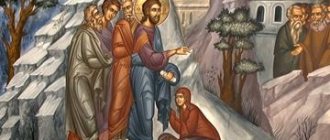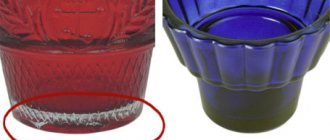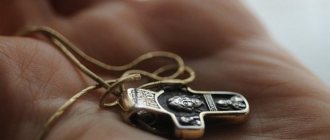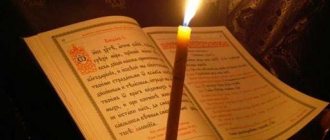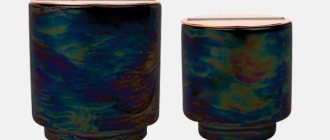A church lamp is considered one of the main symbols of a person’s unquenchable faith in God.
In ancient times, Christians illuminated dark caves with it, where local residents gathered to perform Divine services. There they hid from possible attacks from enemies and pursuers.
Later, lamps began to be used as decoration for churches and temples, as well as for various church sacraments.
In simple words, a lamp is a modified candle, the flame of which does not go out for a long time. Depending on the dimensions, methods of use and application, there are several types of lamps:
- table and wall;
- hanging - found only in churches and temples;
- extinguishable;
- inextinguishable (with continuous burning) - located near icons, relics of saints, revered shrines;
- for church processions - short candles of wide diameter are used, inserted into an oblong vessel, which promotes long and even burning;
- for home use.
The main components of the lamp are a paraffin reservoir, a stand of any shape, and a colored crystal glass on it. Red is used for Easter, blue or colorless is used during Lent, green is used daily.
The meaning of a church lamp
The smoldering lamp symbolizes the outlines of Divine light emanating from heaven. The luminous attributes of temples were never used for their intended purpose. They personify spirituality and make a believer think about the most intimate things.
Thinking begins about what has been done in this life and how much remains to be done, about the meaning of existence and the afterlife. At such moments, enlightenment comes, and all bad deeds are revealed, for which you must repent.
A lamp burning in front of the image of a saint means sincere gratitude to him for the forgiveness and salvation of the soul. Cemetery lights mean a kind of prayer for forgiveness of the sins of the deceased. In a home setting, a lamp indicates observance of the rules of God's law.
It is worth noting: you should not approach the lamp with a bad mood and a closed heart. A person must be determined to communicate with God. What happens in the soul at this moment is considered especially valuable.
Orthodox Life
Priest Andrei Chizhenko explains.
According to Orthodox doctrine, man is a two-part being: spiritual and physical. The soul is the image and likeness of God in man. Through the body, a person connects with the material animal world. This is the great task of man. To deify oneself (that is, to begin the path of ascent to God, the path of knowing Him, uniting with Him, or rather, with Divine uncreated energies) and through deification to deify and sanctify the rest of material nature, since man is its center and king. It seems to exist at the intersection of two worlds - spiritual and material. Based on this, the human body is a collaborator with the soul in the matter of salvation. It is the essence of the temple of God. This is why Orthodoxy treats the body so carefully. This can be seen from the burial order.
Therefore, all Church Sacraments and, as a consequence, divine services also have a dual nature. Example: in the Sacrament of Baptism, the priest invokes the name of the Holy Trinity - this is the spiritual main component. But the substance of baptism is completely material – water. Sacrament of Communion. Its core is the Body and Blood of Christ. And the substances for the Sacrament are prosphora, wine, water. Therefore, Orthodox worship influences the grace of the Holy Spirit not only on the soul, but also on the body. Anointing oil (touch), ringing bells, singing (hearing), icons, painting (sight), prosphora, Epiphany water (taste), burning incense (smell).
The family is a small church. This is also a kind of service to God and one’s neighbors. Naturally, we want God’s grace to sanctify ourselves and our homes, to protect us from all evil and defilement. In addition, in paradise the righteous and holy angels are in continuous worship - the praise of the Almighty. Therefore, with God’s help, we try to continue church services (within reasonable limits, of course) at home. Similar to this is the monastic rite of panagia (from Greek - “all-holy”), when the Mother of God prosphora, from which a piece is taken out in honor of the Virgin Mary at the proskomedia after the Liturgy, the monks solemnly transfer from the temple to the refectory, where they eat it with certain prayers, and then begin meal. Thus, the Liturgy seems to continue, and it continues in the cell conditions of monastic dormitories. In a spiritual sense, approximately the same thing happens to us when we seem to “bring the temple and worship home,” arranging from our lives a worship service, a sacrifice to the Almighty. That’s why, for example, earlier in every Orthodox home there was a “red” (beautiful from outdated) corner where icons were placed, incense was burned, and a lamp was lit. Often it was made to the east, like the altar of a temple. As a matter of fact, the red corner is a kind of home altar. In general, this is a very good tradition. Correct. The family makes a feasible sacrifice to God and arranges a dwelling for Him in their house, and He, of course, settles in it, because the loving hearts of His children long for a meeting with their Heavenly Father.
It is not always possible, of course, to arrange a red corner to the east in modern conditions, but, in principle, every family can do it. This is our expression of love for God. The only thing I would like to say about this from experience... It is still necessary to separate a place in the house for the images of saints, so to speak, to clear it from other worldly things. Otherwise, you often see in houses how icons are filled with glasses or other completely worldly things. Sometimes other involuntary sacrilegious acts occur when icons are placed together with the increasingly popular Japanese netsuke gods, various “money toads” that “bring” wealth and success, or erotic paintings. Of course, this is unacceptable. A person must understand himself, Whom he serves: Christ or Belial. It is better to throw away or burn pagan idols and not keep them at home.
As for the lamp, for example, for me it burns constantly for days. Let us remember the parable of the ten virgins (see Matt. 25:1–13). In my opinion, a burning lamp, caring for it, buying lamp oil, candles for lighting it is our feasible sacrifice to Christ (a kind of tactile prayer to God) and a feasible financial sacrifice to the Church (lamp oil, candles, wicks, the lamp itself). Some people light a lamp before prayer. This is also good and beneficial. God will accept any sacrifice feasible for a person if it is made with reverence and a loving heart. The lamp, of course, is lit in front of the icons.
From my experience I will say that for a lamp it is better to take purified specialized lamp oil. No matter how much I tried to use regular sunflower oil and even refined sunflower oil, it burned poorly, the lamp smoked and became clogged.
As for incense - incense and incense, it is also quite possible to use it at home. You just need to not imitate censing by a clergyman in the temple (this is still the prerogative of the priest), but rather burn incense rather than burn incense with it.
Now in church shops there is a very large selection of both incense and censers. There are special “spiders” - light metal structures that are attached to the lamp. There is a platform on top of them. Incense is placed on it. From the warmth of the lamp fire, the metal heats up - and the incense begins to smell fragrant. There are special stationary censers - clay, porcelain, metal. They need coal. It is lit, placed in a censer, and pieces of incense are placed on top. The lid of this censer has special holes for smoke. You can light censers before prayer, you can walk through the house with the Jesus Prayer or any other prayer, filling its rooms with a heartfelt appeal to God, which rises into the sky as easily as smoke from a censer.
Burnt coals should be disposed of as follows. If you live in a private house, it is advisable to make a hole in clean soil in the front yard or garden, perhaps under a tree or bush, where you can shake out the ashes (including incense) from burning consecrated things. You can throw ashes into running water or into a river. If you live in an apartment, then it is also advisable to burn the remains of consecrated things somewhere in the park or in flower beds, then bury the ashes in clean soil. You can shake out the remains of burnt coal into flowerpots with indoor plants.
What I would like to warn against.
There is no need to turn your entire house into a church. It is important to understand that you should not only pray in the house, but also live. One or two or three places in the house allocated for spiritual needs are enough. Leave space in your home for yourself, your spouse, and your children. Everything is good in moderation.
Priest Andrey Chizhenko
How to make a lamp
Making it yourself is not at all difficult. First you need to decide on the basis. It can be any kind of tin can, for example, coffee or cookies. The color can also be absolutely any.
So where to start:
- Prepare medium-hard wire and a ballpoint pen.
- Place the rod crosswise on top of the wire. Wrap it with wire to form a spiral, and each curl fits tightly to each other.
- Take out the rod and place the resulting holder exactly in the center of the can on the side of the hole. The protrusion beyond the base should not exceed 0.5 cm.
- Punch small holes on the sides of the jar with an awl through which the holder will pass.
- Pull it through the holes, bending the protruding ends.
To make a wick, you will need a small piece of medical bandage, which must be cut into two equal parts. On one side we tie the resulting strips into a knot, roll them up well and tie them.
We drag the wick into the holder with a thin wire, pulling out 2 cm, and cut out the top knot. Then fill the lamp with oil and carefully light it.
Story
The first lamps are primarily lamps. The word itself is of Greek origin. The literal translation is “a lamp burning before the saints.” Initially, they were actually used for lighting in dark caves by the first Christians. There they held their services, hiding from possible pursuers.
Gradually, lamps became the most important detail of the decoration of the temple and an attribute of some church rituals. The premises of almost any church are quite light during the day, but it is impossible to find a building without burning candles or lamps. This evokes in the souls of believers a certain mood for communication with the Almighty. It doesn’t matter for what purpose you visit the temple: to pray for health or peace of soul, to repent or to thank God. Anyone who enters here will definitely light a candle, a symbol of faith in God.
When can you light a lamp at home in front of icons?
Despite the fact that the lamp is a powerful symbol of turning to God, you can pray at home without it. If you still decide to light a church lamp, then there is no need to attach any supernatural significance to this.
Many people mistakenly claim that the flame is sacred and the smoke has magical powers. In fact, lighting a lamp is a good old tradition that does not contain any sacred meaning.
It is used on church holidays, during Sunday services, during daily prayers, even on ordinary days its use is not prohibited.
Kinds
Today you can find lamps of completely different shapes, sizes, types and materials. Its components remain unchanged: an oil reservoir, a stand and a glass to protect the flame. If the lamp is pendant, then most likely it does not have a stand - it is replaced by a decorative element, and there must be three metal cords that hold the tank.
Types of vessels vary depending on the dimensions and methods of their use:
- Tabletop, wall and hanging (used only in churches).
- Extinguishable and inextinguishable (placed in front of relics and relics).
- For home use, temple and church processions.
- Ceramic and glass.
- Made from colored glass or painted.
Closed memorial lamps are lit at the cemetery
You can buy lamps of different shapes and types for home use, but the most convenient are glass table lamps, but you will definitely need to purchase a stand for them (it protects against ignition if the glass cracks). In this case, lamps can be simple or decorated with carvings and paintings.
How to light a lamp correctly
- The wick inserted into the float is pulled to the middle and dipped into the oil with the edge that will then need to be set on fire.
- Pull it out by the dry side so that the edge of the wick stands out by 2 - 3 mm;
- The float is positioned so that the wick is completely immersed in the oil.
- They light the lamp with a flame from a consecrated church candle (it is prohibited to do this with a match or lighter).
Features of special candlesticks on graves
The candlestick in the cemetery regulates the strength of the fire. He doesn't let it fade or get too hot. This property is determined by the materials, shape, and configuration of the elements.
For funeral rituals, budget plastic lamps are purchased at graves. They consist of a translucent container, a tin lid, and a candle. They have positive and negative characteristics:
| Advantages | Flaws |
| Low price | Primitive design |
| Easy to move | Poor stability of the lamp |
| Burning time at the grave is up to 8 hours | For one time use only |
| Maintenance free | Possible fire |
| Availability | Possible burns |
Versions with glass containers of different colors are similar. They can be filled with liquid oil instead of paraffin or wax.
The decorated grave will be complemented by a permanent reusable lamp. The product has a high price and workmanship. You can choose materials, sizes, and unique decorative elements.
Advantages and disadvantages:
| Advantages | Flaws |
| Reliability | High price |
| Sustainability | Installation space required |
| High quality | Installation required |
| Natural materials | Requires maintenance |
The shape of the standard model is a hexagon or cylinder with a dome-shaped lid with a cross.
Popular stationary lamps for placement on a grave are made of stone, metal, glass (combinations thereof). Granite and gabbro make neat structures on an open grave. The disadvantage is that they do not protect the flame from wind and precipitation.
Oil
Real oil for lamps is wood. This is the name given to a product obtained from the fruits of olives growing on a tree, and not from herbs or seeds. Spruce is considered the purest and highest quality oil of the highest grade. When burning, it does not form soot and does not emit any harmful substances.
Due to its purity and healing properties, oil is used both for anointing the sick and in baptismal rites. Throughout the thousand-year history of Christianity, olive oil was considered a worthy sacrifice to God.
What should it be
Quality is of utmost importance. And not only because it affects health in some way. By kindling it, we open our heart to God, which must be pure: there should be no anger, no resentment, no bad thoughts in it. Likewise, oil cannot be of poor quality, cheap, or unclean. The clergy believe that the use of low-quality oil is a sign of impoverishment of faith, a permissive attitude towards piety, and the perception of shrines exclusively as some kind of primitive attribute.
Device
Essentially, a lamp is an improved candle. One option is a container with paraffin, usually a glass (crystal) cup, on a stand. Reusable use is ensured by simple replacement of flammable material. This is typical for desktop products. The stand is metal with a border and figured legs, often decorated with faith. Replaceable cups, different colors:
- red - for Easter time;
- green - for daily use;
- blue, purple or colorless - for Lent.
Supplied with wicks. They can be of different designs:
- A thin plate with a small hole in the middle for a wick. It is placed on the surface of the oil, one end of the wick is above the plate (the length of no more than one or two match heads), the second is lowered into the oil.
- The Greek design is a cork float with a solid wick stuck through it.
The operating principle is the same. The design provides the most comfortable conditions for long-lasting flame maintenance. Wide short candles are used in lamps for religious processions. They are inserted into an oblong-shaped vessel, closed on top with a tin lid with holes. This shape allows the flame to burn long and evenly.
